Recent Articles
Popular Makes
Body Types
2021 Jeep Gladiator vs. 2021 Toyota Tacoma
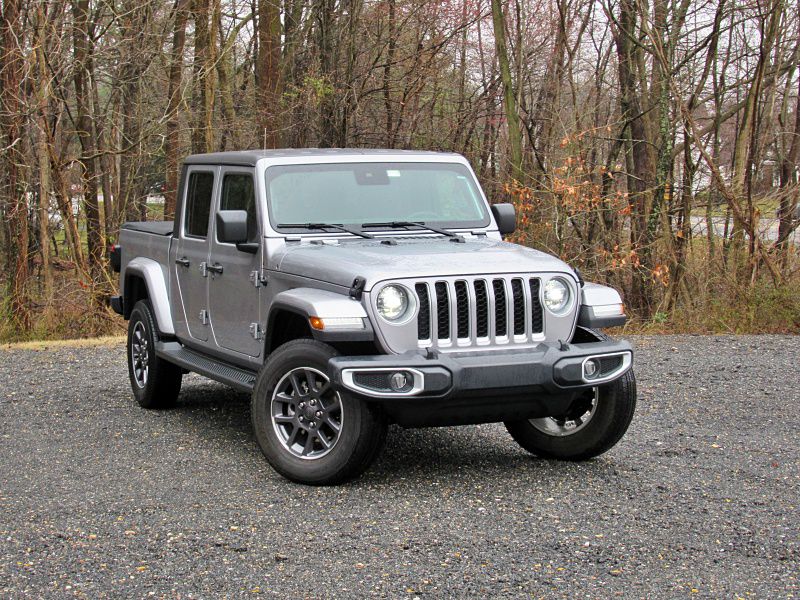
2021 Jeep Gladiator Overland ・ Photo by Brady Holt
What if instead of being an SUV, the Jeep Wrangler were a pickup truck? Instead of an enclosed cargo hold, you get a 5-foot-long pickup bed sticking off the end of a Wrangler body. It’s called the Jeep Gladiator, and it has quickly become a force in the mid-size pickup class. It looks like no other pickup, its unique features include a convertible roof and removable doors, and has the promise of Jeep’s storied off-road capability. And like the Wrangler, it gets expensive in a hurry.
Is the 2021 Jeep Gladiator merely a flashy, pricey toy? Or can it successfully challenge the best-selling pickup in its class: the 2021 Toyota Tacoma? Read on to learn how these two trucks stack up in a variety of ways, and which one is our top pick overall.
Exterior Design
There’s no visual similarity between the Gladiator and Tacoma. The Tacoma is a classically handsome truck, with an angular body, confidently flared fenders, and an upright grille. Its white taillights are maybe 15 years out of style, but there’s otherwise little to complain about in this well-regarded pickup body.
Then there’s the Gladiator, which looks like the Wrangler with a bed that it essentially is. Its round headlights, vertical grille slats, and old-fashioned fenders date back to World War II, and the body itself has straight lines and sharp angles. In another difference, the Tacoma is sold with a choice of extended-cab and crew-cab configurations, and a choice of 5-foot or 6.1-foot beds. Every Gladiator is a four-door crew cab with a 5-foot bed, though you can choose between a fabric roof or removable hardtop. While we won’t pick an aesthetic winner, Toyota gets the nod for engineering a wider set of options.
Toyota Tacoma

Photo by Brady Holt
Interior Design
Both trucks’ interiors echo their exterior design philosophies. The Tacoma is rugged without feeling cheap, with a blocky dashboard and mostly appropriate interior materials. Our test truck had sturdy and nicely textured leather upholstery, which exemplifies the Tacoma’s niche: It’s not a downscale vehicle, but it doesn’t try to provide car-like buttery smooth luxury. A 7-inch touchscreen infotainment system is standard equipment while an 8-inch unit is included on most models. These screens were both upgraded last year.
The Gladiator’s dashboard, meanwhile, is shared with the Wrangler. It’s thin and upright, obviously a Jeep’s. Yet it’s less of a retro throwback than the exterior, thanks to modern infotainment systems (with a choice of 5-inch, 7-inch, and 8.4-inch screens), user-friendly controls, and plenty of available luxury features. Painted sheetmetal is visible from the inside, but it’s part of the ambiance rather than looking like an oversight, especially on a brightly colored Gladiator. Our main objection is the exposed white Styrofoam on the hardtop roof; we also tested one Gladiator with metal trim starting to peel off its interior door handle. Since both trucks have simple controls and generally solid build quality, we’ll call this category a tie.
Tie
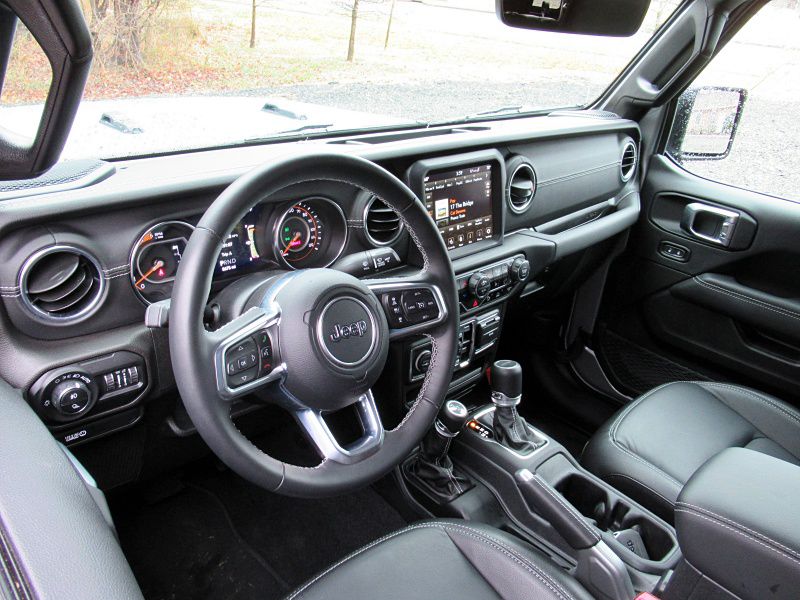
Photo by Brady Holt
Interior Comfort
The Gladiator is longer and taller than most mid-size pickups with 5-foot beds, including the Tacoma. And the benefit goes to the passenger compartment, with the Jeep providing a roomier interior than competing trucks. The front and rear seats are high and comfortable, and there’s ample headroom. Leather upholstery and heated front seats are available, but power-adjustability is not.
In contrast, the Tacoma has an uncommonly cramped interior for a modern vehicle. The driver’s seat is awkwardly low to the floor yet still provides limited headroom for taller drivers. And the rear seat has limited leg space as well. A 10-way power-adjustable driver’s seat debuted last year and is standard on all but the base SR trim level, and it’s a welcome improvement over old Tacomas’ fixed-height seat, but there continues to be too little space for larger folks to easily get comfortable.
Jeep Gladiator
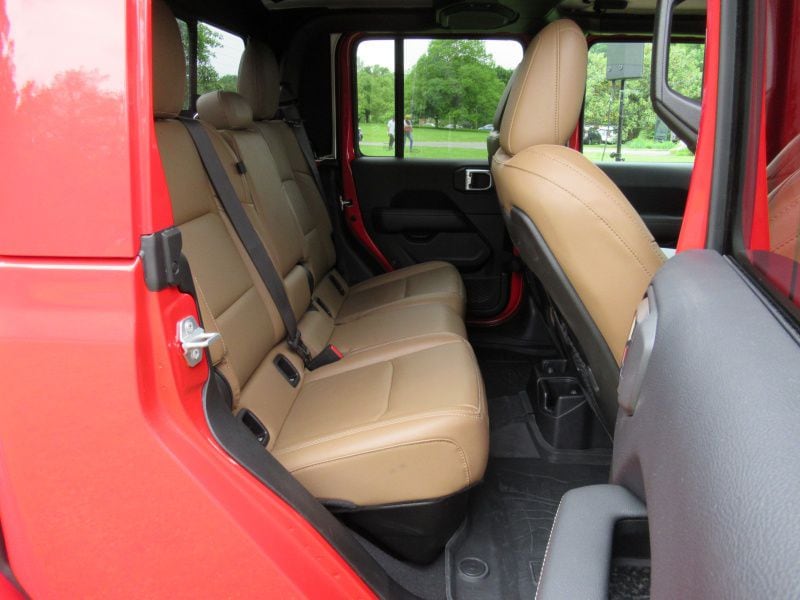
Photo by Brady Holt
Ride and Handling
The Jeep Wrangler isn’t known for its on-road driving experience, with a bouncy, noisy ride; vague, slow steering; and clumsy handling. The Gladiator improves on that, thanks to the stabilizing influence of a longer wheelbase and a different rear suspension. It’s smoother than the Wrangler and about as gentle as the Tacoma. However, elevated wind noise remains almost inevitable given the Gladiator’s boxy shape and removable roof. And going around a curve or even tracking straight on a highway requires extra attention in a Gladiator. This isn’t a peaceful, relaxing truck. And its extra length, while useful for rear legroom, results in an inconvenient 22.3-foot turning radius.
Thanks to its fixed roof, the Tacoma is noticeably quieter than the Gladiator, especially on the highway. And while its handling is less agile than some of its other competitors, the Toyota feels more connected to the road than the Jeep. Plus, if you skip the optional 6-foot bed, you shave 2 feet off the Gladiator’s turning radius. It’s not a great driving experience, but at least you don’t have to treat a Tacoma so differently from an ordinary vehicle.
Toyota Tacoma
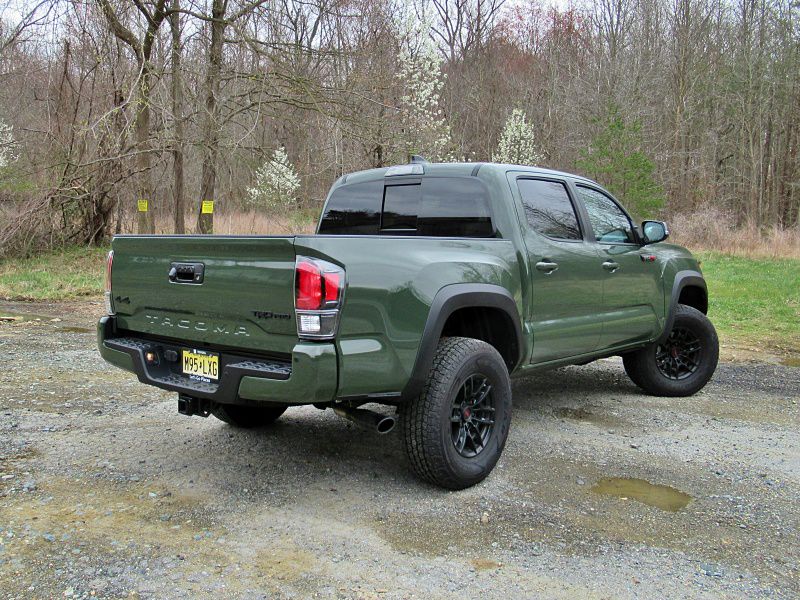
Photo by Brady Holt
Acceleration and Fuel Economy
The Tacoma and Gladiator each come with a choice of two engines, but we prefer the Jeep both times. Standard on the Gladiator is a 3.6-liter V6 that makes 285 horsepower and 260 lb-ft of torque, with a choice between an eight-speed automatic transmission and a six-speed manual. This engine provides agreeably strong, drama-free acceleration and decent gas mileage: an EPA-estimated 17 mpg in the city, 22 mpg on the highway, and 19 mpg overall with the automatic transmission and a standard four-wheel-drive system.
The equivalent Tacoma has a 3.5-liter V6 with 278 horsepower and 265 lb-ft of torque, with a choice of a six-speed automatic or six-speed manual. This engine doesn’t live up to its on-paper promise, making a hearty noise but accelerating less eagerly than the Jeep. Gas mileage is slightly better: 18 mpg city/22 mpg highway/20 mpg combined with the automatic and 4WD, and you can save even more fuel by choosing rear-wheel drive. The Tacoma also offers a lethargic base four-cylinder engine that burns as much gas as its V6. The mileage leader is the Gladiator with an available 3.0-liter turbodiesel V6, which scores 22 mpg city/28 mpg highway/24 mpg combined. We averaged 26 mpg in a diesel Gladiator.
Jeep Gladiator
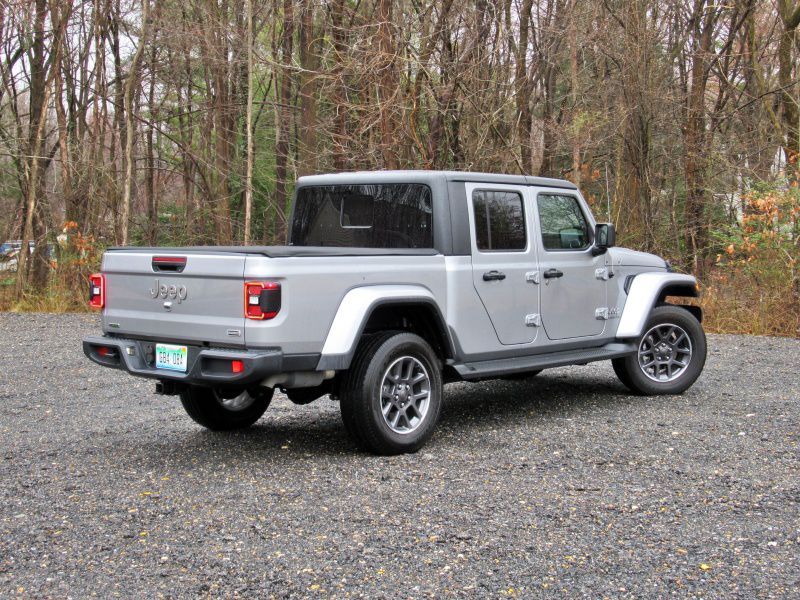
Photo by Brady Holt
Capability and Utility
Jeeps are known for their off-road capability, and even the base Gladiator has standard four-wheel drive and 10 inches of ground clearance. You can upgrade to the boulder-climbing Rubicon and desert-running Mojave models as well. Still, the Gladiator’s long wheelbase gives it less flexibility than a Wrangler to tackle some steep grades without bottoming out. When playtime is over, the Gladiator can tow up to 7,650 lbs, excellent for a mid-size truck, and haul a payload of up to 1,700 lbs. The diesel dips to 6,500 lbs and 1,325 lbs, respectively, because the trademark Jeep grille doesn’t let in enough airflow. But with 442 lb-ft of torque, it won't fuss when it is working within its prescribed limits.
Meanwhile, the Tacoma’s max towing capacity is 6,800 lbs, and its top payload limit is 1,525 lbs. What’s more, four-wheel-drive crew cab models (equivalent to the Gladiator) tow just 6,400 lbs and handle payloads of only around 1,100 lbs. The Tacoma offers a 6.1-foot bed in addition to a 5-foot bed like the Jeep’s, and it can keep up with the Gladiator off-road — especially in TRD Pro form — but it’s less ready for work overall.
Jeep Gladiator
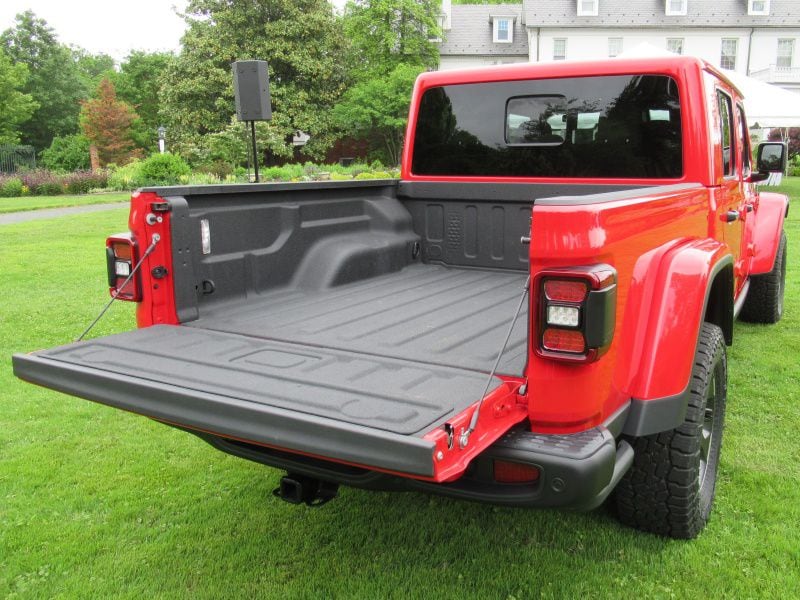
Photo by Brady Holt
Safety
The Tacoma comes standard with a comprehensive suite of advanced safety features. Even the base model includes automatic emergency braking, lane-keep assist, adaptive cruise control, and more. Blind-spot monitoring and a rear cross-traffic alert are widely available, too. The Tacoma earned a class-competitive four out of five stars in National Highway Traffic Safety Administration crash testing and achieved the top Good score in most crash tests conducted by the Insurance Institute for Highway Safety.
The Gladiator is available with all of those features, but none of them is standard. Nor can you get side-curtain airbags; along with the Wrangler, the Gladiator is just one of just two vehicles in the U.S. that leave out this feature, which protects the front and rear passengers’ heads in a side impact or rollover. The Tacoma also includes knee-protecting airbags, which the Gladiator does not. The Gladiator hasn’t been fully crash-tested, but it matched the Tacoma’s four-star performance in a NHTSA frontal-impact evaluation.
Toyota Tacoma
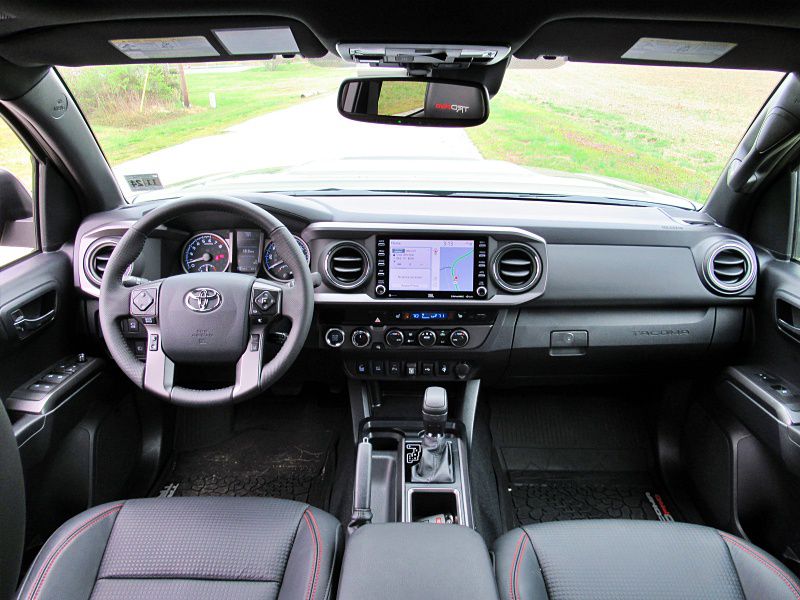
Photo by Brady Holt
Pricing and Features
The Gladiator is the most expensive truck in its class. That’s especially true if you look at base prices; the 2021 Gladiator starts at $33,565 compared with $26,250 for the base 2021 Tacoma. However, the Gladiator has standard equipment that the Tacoma and other competitors don’t: a V6 engine, a crew-cab body, and four-wheel drive.
That closes the gap, but the Gladiator is missing some standard features of its own: power windows and locks and an automatic transmission. Add those basics and the mandatory destination charge, and you’ve hit $40,000. Keep going, and you can even push the truck past $60,000. Meanwhile, a Tacoma V6 4WD automatic crew cab (with even more features than the $40,000 Gladiator) starts at $33,610. That’s also expensive, to be clear, and a well-equipped Tacoma Limited or TRD Pro can approach $50,000. Plus, the Gladiator offers unique features in its convertible roof, fold-down windshield, and removable doors. Both trucks have promising reputations for longevity and resale value, but the Tacoma is clearly the less expensive of the two.
Toyota Tacoma
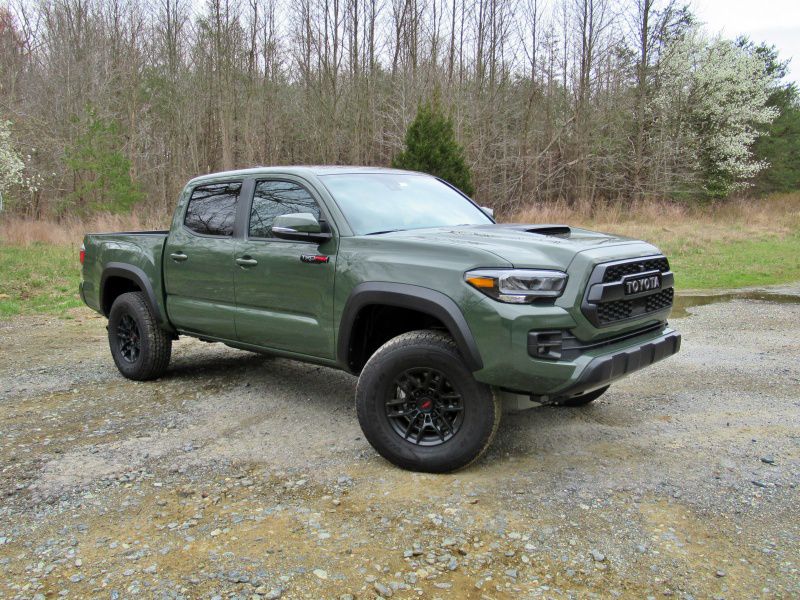
Photo by Brady Holt
Final Thoughts
Speaking generally, the Tacoma and Gladiator are similar trucks. They’re “lifestyle vehicles” designed to look and feel tough, and to successfully drive through the mud. They’re not cushy, limo-like behemoths like the more popular (and not much more expensive) full-size pickups.
The Gladiator adds a unique twist to this formula. It brings the established, beloved flavor of a Jeep Wrangler, and then improves its utility with a pickup bed and mightier towing and payload limits. That means you get the unmistakable style and unmatchable open-air feeling of a Jeep, but you can still tow and haul. The more conventional Tacoma has some advantages, to be sure — a much lower price tag, better crash protection, slightly better gas mileage, and slightly better handling. But it’s not outstanding in any of those areas. If you like conventional mid-size pickups, you can get roomier, more agile, better-riding alternatives to the Tacoma. Higher price or not, just one of these two trucks has something truly special to offer. Throw in its roomier interior, higher towing and payload numbers, and superior powertrains, and the Gladiator is our clear winner.
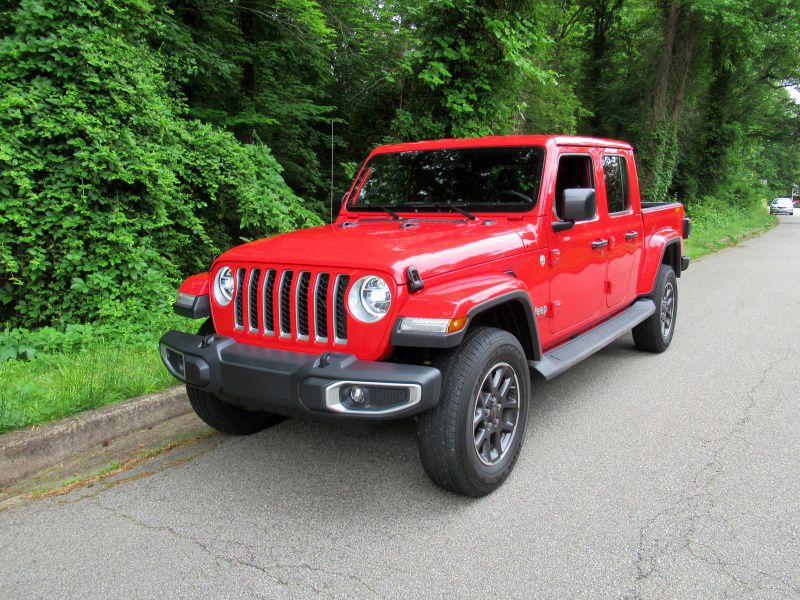
Photo by Brady Holt